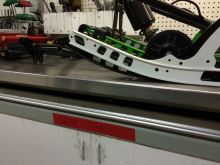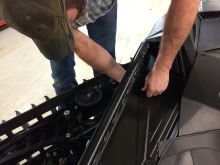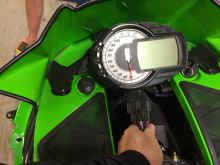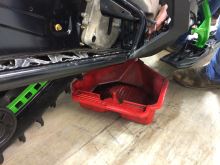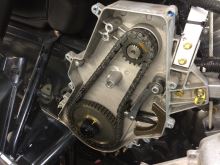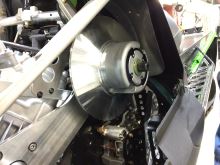- Although Forum Moderator Christopher Parrett was technically “helping” on this project … I think this is about as close as he got to getting his hands dirty—holding a camera while he shot a close-up of Shay Smith doing all the work.
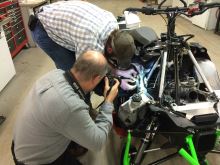
f you’re going to steal parts, at least steal the good stuff. Although there’s been a lot of Forum discussion about going to a belt drive, we thought that given the opportunity to acquire Borg Warner chains and gears, we better make the most of it.
And when it comes to clutching, the Team Rapid Reaction secondary clutch is definitely the way to go.
To remove the hood, the first thing you need to do is pull the cable housing attached to the instrument gauge. For the hood itself, there will be six torque screws to remove. Four are the same length and the two under the nose are longer.
Once the hood is removed it will be easier to remove the pipes, clutches and chaincase.
To remove the belt, you need to take out the bolt that holds on the secondary clutch, reverse the silver metal spacer and then put the bolt back in and tighten it to spread the sheaves.
On the chaincase, remember to remove the oil pressure sensor and the odometer cable and move them out of your way.
With the clutches removed, you can now get at the torque plate.
Before you crack open the chaincase, make certain you have a catch-pan to collect the gear oil. There are few things worse than having gear oil on the floor of your shop.
With the chaincase cover removed, you can get at the chain tensioner and gears.
If you look closely on the upper right side of the chain you will notice the darker link (about fourth from the end). Remember to have this link facing out when your replace the chain.
With the chain in place (notice the darker link in the middle of the chain) it’s time to replace the chain tensioner. Don’t get your chain too tight at this stage … it will automatically increase the tension as needed.
Although many mechanics will tighten bolts up to where they think they should be, you really ought to invest in a torque wrench and set bolts to manufacturer’s specs.
Once you’re ready to replace the clutches, remember the secondary will go on in two stages.
This is the second stage of the secondary.
Use a torque wrench on your clutches to meet manufacturer’s specs.
When installing the springs that hold on the pipes, be sure to have the long part of the spring facing the engine.
 All the 16 updates plus a 3" then boards, bumpers, skis, HCR post (forward if possible).... If they let you into the accessory catalog we just as well have the best! Then lets get this thing on a diet and do a belt drive and a BDX hood and of course a tether for safety. Now for the FUN because HORSEPOWER is ALWAYS FUN! Snowest can pick the hp but I vote supercharger. The stock black and green are classic and refined besides then it's a sleeper until it's fired up.
All the 16 updates plus a 3" then boards, bumpers, skis, HCR post (forward if possible).... If they let you into the accessory catalog we just as well have the best! Then lets get this thing on a diet and do a belt drive and a BDX hood and of course a tether for safety. Now for the FUN because HORSEPOWER is ALWAYS FUN! Snowest can pick the hp but I vote supercharger. The stock black and green are classic and refined besides then it's a sleeper until it's fired up.



